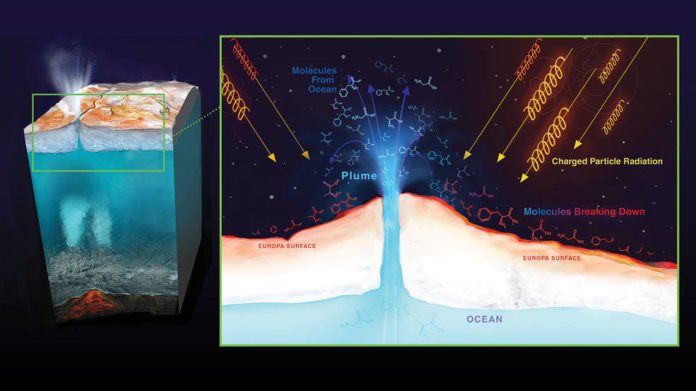New far-reaching mapping of the radiation pulverizing Jupiter’s icy moon Europa uncovers where researchers should look – and how profound they’ll need to go – while searching for indications of habitability and biosignatures.
Since NASA‘s Galileo mission yielded solid confirmation of a worldwide sea underneath Europa’s cold shell in the 1990s, researchers have considered that moon a standout amongst the most encouraging spots in our nearby solar system to search for ingredients to help life. Even proof the salty water sloshing around the moon’s inside advances toward the surface.
By analyzing this material from the inside, researchers creating future missions would like to take in more about the conceivable tenability of Europa’s ocean. Although, Europa’s surface is besieged by a steady and serious impact of radiation from Jupiter. This radiation can pulverize or adjust material transported up to the surface, making it more troublesome for researchers to know whether it really represents conditions in Europa’s sea.
As scientists plan for upcoming exploration of Europa, they have grappled with many unknowns: Where is the radiation most intense? How deep do the energetic particles go? How does radiation affect what’s on the surface and beneath — including potential chemical signs, or biosignatures, that could imply the presence of life?
A new study by the NASA’s Jet Propulsion Laboratory, Pasadena, California, represents the most total displaying and mapping of radiation at Europa and offers key pieces to the puzzle.
Tom Nordheim, a research scientist at NASA’s Jet Propulsion Laboratory, Pasadena, California said, “If we want to understand what’s going on at the surface of Europa and how that links to the ocean underneath, we need to understand the radiation. When we examine materials that have come up from the subsurface, what are we looking at? Does this tell us what is in the ocean, or is this what happened to the materials after they have been radiated?”
Scientists used the data from Galileo’s flybys of Europa and electron measurements from NASA’s Voyager 1 spacecraft to study the electrons blasting the moon’s surface. They found that the radiation doses vary by location. The harshest radiation is concentrated in zones around the equator, and the radiation lessens closer to the poles.
Mapped out, the harsh radiation zones appear as oval-shaped regions, connected at the narrow ends, that cover more than half of the moon.
Chris Paranicas, a co-author from the Johns Hopkins Applied Physics Laboratory in Laurel, Maryland said, “This is the first prediction of radiation levels at each point on Europa’s surface and is important information for future Europa missions.”
Presently researchers know where to discover areas slightest modified by radiation, which could be crucial data for the JPL-drove Europa Clipper, NASA’s mission to orbit Jupiter and screen Europa with around 45 close flybys. The spacecraft may dispatch as right on time as 2022 and will convey cameras, spectrometers, plasma and radar instruments to explore the creation of the moon’s surface, its sea, and material that has been launched out from the surface.
In his new paper, Nordheim didn’t stop with a two-dimensional map. He went further, checking how far underneath the surface the radiation enters and building 3D models of the most exceptional radiation on Europa. The outcomes disclose to us how profound researchers need to burrow or bore, amid a potential future Europa lander mission, to discover any biosignatures that may be safeguarded.
The answer varies, from 4 to 8 inches (10 to 20 centimeters) in the highest-radiation zones – down to less than 0.4 inches (1 centimeter) deep in regions of Europa at middle- and high-latitudes, toward the moon’s poles.
To reach that conclusion, Nordheim tested the effect of radiation on amino acids, basic building blocks for proteins, to figure out how Europa’s radiation would affect potential biosignatures. Amino acids are among the simplest molecules that qualify as a potential biosignature.
Kevin Hand, co-author of the new research and project scientist for the potential Europa Lander mission said, “The radiation that bombards Europa’s surface leaves a fingerprint. If we know what that fingerprint looks like, we can better understand the nature of any organics and possible biosignatures that might be detected with future missions, be they spacecraft that fly by or land on Europa.”
The study is published today in Nature Astronomy.
